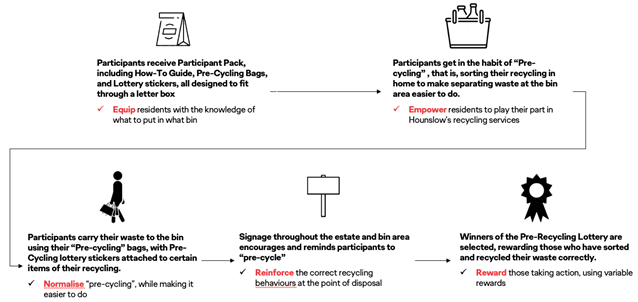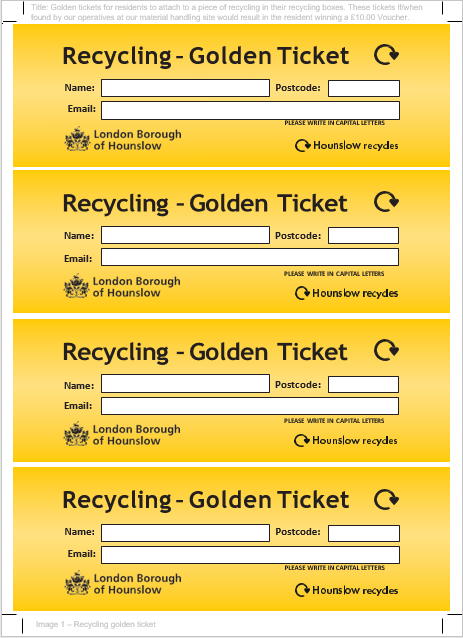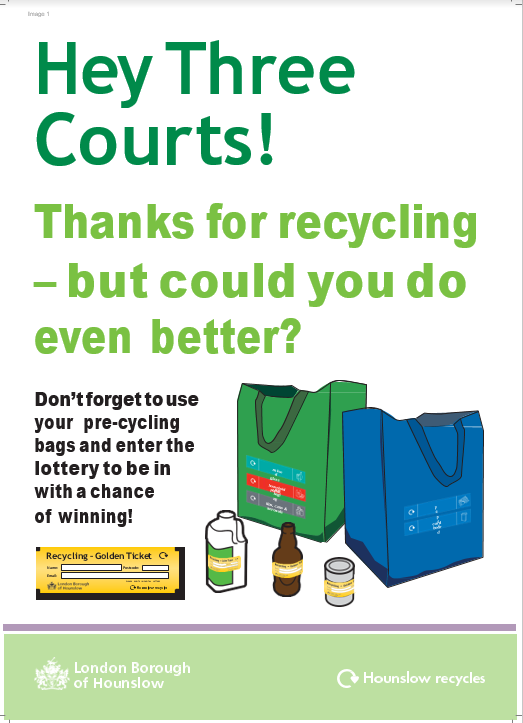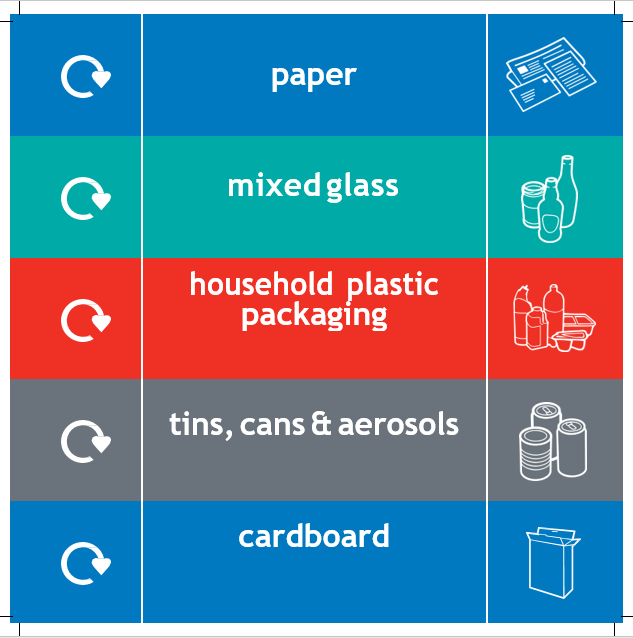Planned trial methodology
To capture the impact of our intervention, a Randomised Control Trial (RCT) was planned across ‘nudge-ready’ estates in the borough, where ‘nudge-ready’ refers to properties which have an acceptable provisioning of waste and recycling bins already in place.
Nine estates (1,087 households) were randomly assigned to the treatment condition; these residents received the intervention. A different selection of nine estates (925) was allocated to the control group, which received no intervention. Care was taken to control for the relative size (number of flats), structure (courtyards, stairwells, etc), demographic factors (socioeconomic status) and the management type of participating estates. A bin fill survey and waste composition analysis were carried out by Hounslow Council and Recycle 360 to establish baseline measurements for both groups for the following variables:
- amount of recycling waste (kg/hh/ww)
- amount of residual waste (kg/hh/ww)
- amount of residual waste in the recycling bins (kg/hh/ww)
- amount of recycling waste in the residual waste bins (kg/hh/ww)
Additionally, residents of the estates in the treatment condition received a qualitative survey after the trial period to capture their experience of the intervention.
Limitations
The randomised control trial described coincided with the first and second waves of the COVID-19 pandemic, complicating the distribution of Participant Packs and the collection of associated data.
The following limitations impacted the team’s ability to collect results for the bin fill survey, which aimed to capture volume of waste disposed of by participating estates:
- Resource - The planned approach to measuring the outcome variables of interest with a small dedicated team proved to be untenable in light of the increased demand for waste management services during the COVID-19 lock-down.
- Subjective measurement tools – As a secondary approach, collection crews were tasked with recording bin fill before emptying containers, estimating fill level at 0/25/50/75/100%. Bin fill estimation is subjective and using multiple employees increased the potential for inconsistency, although the assessment instructions were simple and well understood and the ratio level easily determined in quarter bin increments.
- Increased volume of waste: On many sites, both recycling containers and residual waste containers were assessed as 100 per cent full at each visit, meaning any channel shift would be less easily recognisable, or potentially, that residents wishing to put out more recycling were unable to do so.
Due to capacity constraints, only four estates participated in the waste composition analysis, which looked to understand contamination rates of participants’ recycling.
Material was collected on the day of scheduled collection, or on the day before, with bins being replaced at each site. The full bins were returned to the Southall Lane depot, where each pair of sites’ material was tipped on the floor, mixed with a front loading shovel and then separated into two piles. A coin toss was made to chose one of the piles, which was subsequently divided into two further piles. A further coin toss was made to choose a pile from which an appropriate sample of material was taken. Each sample of material was separately sorted into target and non-target materials, and weights of each material were assessed using Recycle 360’s calibrated Adams industrial scales used routinely for recycling material sampling, by a trained operative. Samples were taken before and after the interventions.
There were a number of limitations with the waste composition analysis, including the fact that the analysis period coincided with the second lockdown in the UK, and changes in staff meant that the analysis was not carried out in the desired way. A closer group of sites geographically may have helped.
Results
While some changes were anecdotally indicated at two specific sites for the bin fill survey, the results were unsuitable for statistical analysis and thus haven’t been included here.
The resulting findings from the waste composition analysis are as follows:
Alfred Court and Beaumont Court
| Targets |
Card |
Glass |
Paper |
Plastic |
| Before |
67.65% |
93.72% |
94.9% |
73.15% |
| After |
78.23% |
98.84% |
96.72% |
66.48% |
| Change |
10.57% |
5.12% |
2.22% |
-6.67% |
Kew Court and Pinkham Mansions
| Targets |
Card |
Glass |
Paper |
Plastic |
| Before |
87.78% |
94.24% |
94.15% |
43.40% |
| After |
61.49% |
97.01% |
97.20% |
39.34% |
| Change |
-26.28% |
2.77% |
3.04% |
-4.07% |
The first pair of sites appears to show an improvement following the intervention, while the second pair of sites does not. These results are not statistically significant.
A survey was created to better understand the impact of the interventions for residents. The council worked with Ogilvy to develop a short questionnaire for feedback on the precycling bags, posters, leaflet, and golden tickets. The questions were quantitative: simple, multiple choice and used a 5-point semantic differential scale and qualitative: with more open-ended questions around what could have been improved and what they liked about the interventions. We had intended for the managing agents of the sites to send out the survey on our behalf, they would have more specific data about the property’s occupants with names and personal email addresses which we hoped would yield better participation. We also felt that residents may be more inclined to respond to their managing agent, believing the request is more important than a request from the council. Unfortunately, we were unable to engage with any managing agents and therefore distribution of the survey sat with the council.
To try and reach as many residents as possible several posters with a QR code that linked to the survey were put up in each of the sites bin rooms. Included on the poster was that several respondents would be chosen at random to win a £10 voucher - we hoped this positive reward would encourage participation in the survey. The survey was open for two weeks. Disappointedly, we did not receive any response to the survey across all sites. This consequently meant that we were unable to gain further insight into the success of the interventions from residents' perspectives.




